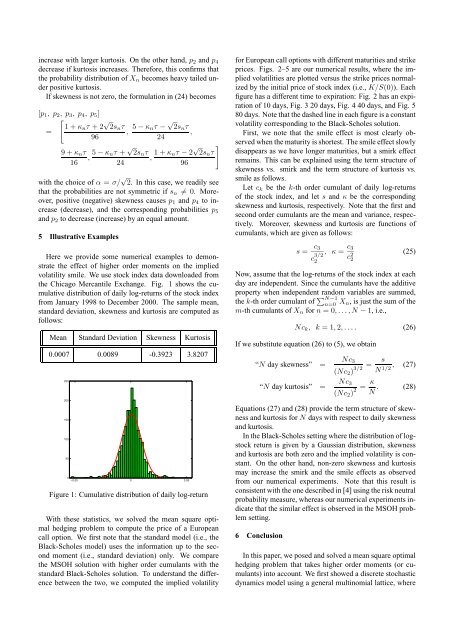Mean Square Optimal Hedges Using Higher Order Moments
Mean Square Optimal Hedges Using Higher Order Moments
Mean Square Optimal Hedges Using Higher Order Moments
Create successful ePaper yourself
Turn your PDF publications into a flip-book with our unique Google optimized e-Paper software.
increase with larger kurtosis. On the other hand, p 2 and p 4decrease if kurtosis increases. Therefore, this confirms thatthe probability distribution of X n becomes heavy tailed underpositive kurtosis.If skewness is not zero, the formulation in (24) becomes[p 1 , p 2 , p 3 , p 4 , p 5 ][=1 + κ n τ + 2 √ 2s n τ969 + κ n τ16, 5 − κ nτ − √ 2s n τ,24, 5 − κ nτ + √ 2s n τ, 1 + κ nτ − 2 √ 2s n τ2496with the choice of α = σ/ √ 2. In this case, we readily seethat the probabilities are not symmetric if s n ≠ 0. Moreover,positive (negative) skewness causes p 1 and p 4 to increase(decrease), and the corresponding probabilities p 5and p 2 to decrease (increase) by an equal amount.5 Illustrative ExamplesHere we provide some numerical examples to demonstratethe effect of higher order moments on the impliedvolatility smile. We use stock index data downloaded fromthe Chicago Mercantile Exchange. Fig. 1 shows the cumulativedistribution of daily log-returns of the stock indexfrom January 1998 to December 2000. The sample mean,standard deviation, skewness and kurtosis are computed asfollows:<strong>Mean</strong> Standard Deviation Skewness Kurtosis0.0007 0.0089 -0.3923 3.8207250200150100500−0.05 0 0.05Figure 1: Cumulative distribution of daily log-returnWith these statistics, we solved the mean square optimalhedging problem to compute the price of a Europeancall option. We first note that the standard model (i.e., theBlack-Scholes model) uses the information up to the secondmoment (i.e., standard deviation) only. We comparethe MSOH solution with higher order cumulants with thestandard Black-Scholes solution. To understand the differencebetween the two, we computed the implied volatility]for European call options with different maturities and strikeprices. Figs. 2–5 are our numerical results, where the impliedvolatilities are plotted versus the strike prices normalizedby the initial price of stock index (i.e., K/S(0)). Eachfigure has a different time to expiration: Fig. 2 has an expirationof 10 days, Fig. 3 20 days, Fig. 4 40 days, and Fig. 580 days. Note that the dashed line in each figure is a constantvolatility corresponding to the Black-Scholes solution.First, we note that the smile effect is most clearly observedwhen the maturity is shortest. The smile effect slowlydisappears as we have longer maturities, but a smirk effectremains. This can be explained using the term structure ofskewness vs. smirk and the term structure of kurtosis vs.smile as follows.Let c k be the k-th order cumulant of daily log-returnsof the stock index, and let s and κ be the correspondingskewness and kurtosis, respectively. Note that the first andsecond order cumulants are the mean and variance, respectively.Moreover, skewness and kurtosis are functions ofcumulants, which are given as follows:s = c 3c 3/22, κ = c 3c 2 2(25)Now, assume that the log-returns of the stock index at eachday are independent. Since the cumulants have the additiveproperty when independent random variables are summed,the k-th order cumulant of ∑ N−1n=0 X n, is just the sum of them-th cumulants of X n for n = 0,...,N − 1, i.e.,Nc k , k = 1,2,.... (26)If we substitute equation (26) to (5), we obtain“N day skewness” =“N day kurtosis” =Nc 3(Nc 2 ) = s , 3/2 N1/2 (27)Nc 3(Nc 2 ) 2 = κ N . (28)Equations (27) and (28) provide the term structure of skewnessand kurtosis for N days with respect to daily skewnessand kurtosis.In the Black-Scholes setting where the distribution of logstockreturn is given by a Gaussian distribution, skewnessand kurtosis are both zero and the implied volatility is constant.On the other hand, non-zero skewness and kurtosismay increase the smirk and the smile effects as observedfrom our numerical experiments. Note that this result isconsistent with the one described in [4] using the risk neutralprobability measure, whereas our numerical experiments indicatethat the similar effect is observed in the MSOH problemsetting.6 ConclusionIn this paper, we posed and solved a mean square optimalhedging problem that takes higher order moments (or cumulants)into account. We first showed a discrete stochasticdynamics model using a general multinomial lattice, where



